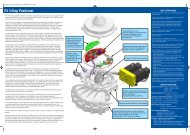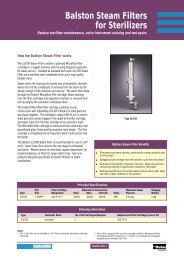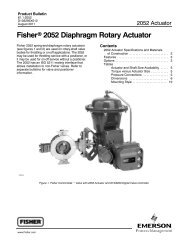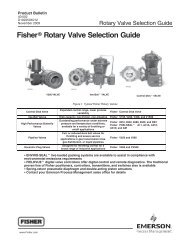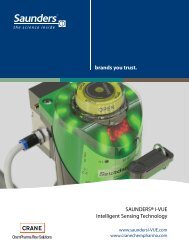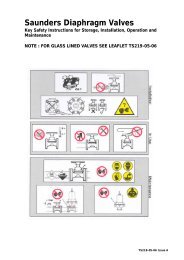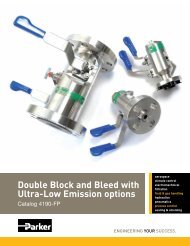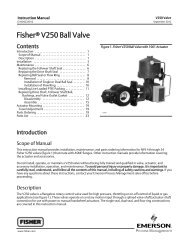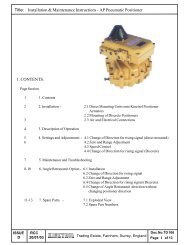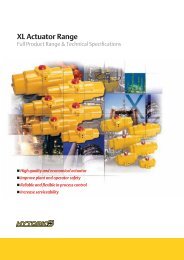Fisher® FIELDVUE DVC6200 Digital Valve Controller
Fisher® FIELDVUE DVC6200 Digital Valve Controller
Fisher® FIELDVUE DVC6200 Digital Valve Controller
Create successful ePaper yourself
Turn your PDF publications into a flip-book with our unique Google optimized e-Paper software.
Instruction Manual<br />
D103605X012<br />
Principle of Operation<br />
July 2012<br />
Appendix A Principle of OperationAA−A<br />
HART Communication<br />
The HART (Highway Addressable Remote Transducer) protocol gives field devices the capability of communicating<br />
instrument and process data digitally. This digital communication occurs over the same two‐wire loop that provides<br />
the 4‐20 mA process control signal, without disrupting the process signal. In this way, the analog process signal, with<br />
its faster update rate, can be used for control. At the same time, the HART protocol allows access to digital diagnostic,<br />
maintenance, and additional process data. The protocol provides total system integration via a host device.<br />
The HART protocol uses frequency shift keying (FSK). Two individual frequencies of 1200 and 2200 Hz are<br />
superimposed over the 4‐20 mA current signal. These frequencies represent the digits 1 and 0 (see figure A‐1). By<br />
superimposing a frequency signal over the 4-20 mA current, digital communication is attained. The average value of<br />
the HART signal is zero, therefore no DC value is added to the 4‐20 mA signal. Thus, true simultaneous communication<br />
is achieved without interrupting the process signal.<br />
Figure A‐1. HART Frequency Shift Keying Technique<br />
+0.5V<br />
0<br />
-0.5V<br />
1200 Hz<br />
“1”<br />
2200 Hz<br />
“0”<br />
ANALOG<br />
SIGNAL<br />
AVERAGE CURRENT CHANGE DURING COMMUNICATION = 0<br />
A6174<br />
The HART protocol allows the capability of multidropping, i.e., networking several devices to a single communications<br />
line. This process is well suited for monitoring remote applications such as pipelines, custody transfer sites, and tank<br />
farms. See table 6‐2 for instructions on changing the printed wiring board DIP switch configuration to multidrop.<br />
<strong>DVC6200</strong> <strong>Digital</strong> <strong>Valve</strong> <strong>Controller</strong><br />
The <strong>DVC6200</strong> digital valve controller housing contains the travel sensor, terminal box, pneumatic input and output<br />
connections and a module base that may be easily replaced in the field without disconnecting field wiring or tubing.<br />
The module base contains the following submodules: I/P converter, printed wiring board (pwb) assembly, and<br />
pneumatic relay. The relay position is detected by sensing the magnet on the relay beam via a detector on the printed<br />
wiring board. This sensor is used for the minor loop feedback (MLFB) reading. The module base can be rebuilt by<br />
replacing the submodules. See figures A‐3 and A‐4.<br />
79




